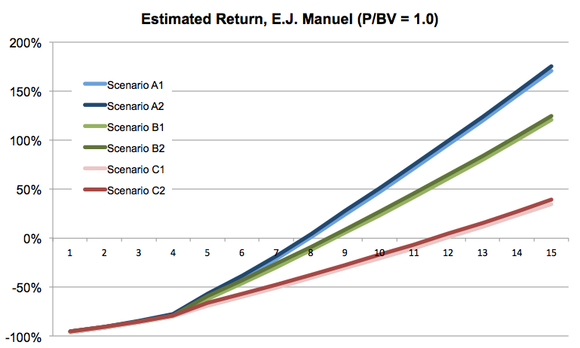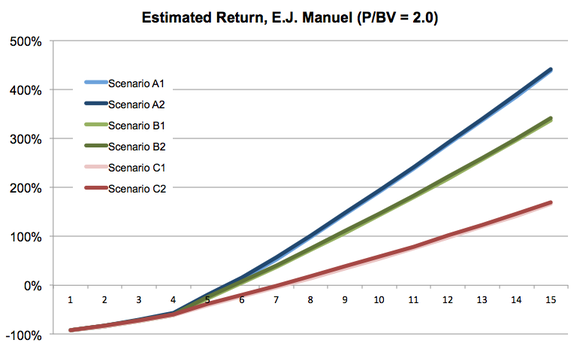Filed under: Investing
Actor Michael B. Jordan has been making quite a name for himself lately, and he's done it without reading a single line. The Chronicle actor set the Internet aflame when he was announced as the new Johnny Storm (aka the Human Torch) in the upcoming "Fantastic Four" reboot from 21st Century Fox . Jordan has taken the criticisms in stride, telling TMZ "They're still going to go see it anyway" when questioned about the complaints surrounding his casting.
The Fantastic Four's Baxter Building may not be the only superhero hangout that Jordan will be visiting in the coming years, however. According to recent rumors, the actor has also met with director Zack Snyder concerning a potential role in the upcoming "Batman vs. Superman" film from Time Warner's Warner Bros. studio.
Holy superhero shenanigans, Batman!
If the potential casting rumor proves true, Jordan would have a small part in "Batman vs. Superman," which would expand into a larger part in future DC Comics movies such as the upcoming "Justice League" film. According to the Latino Review report, the studio is looking for "a black actor in his early 20s who is also physically fit." Jordan is 27, but the production is supposedly working from short lists of actors instead of hosting large casting calls. If he has met with Snyder then it's likely that the "early 20s" specification wasn't a dealbreaker.
Who will he play?
Assuming that Jordan does take a role in "Batman vs. Superman," there are two main possibilities concerning the character he would play. The first is Victor Stone, who after an accident involving a failed dimensional travel experiment is transformed by his father into the hero known as Cyborg to save his life. The other is John Stewart, the third person from Earth to be selected by the Guardians as a Green Lantern (originally serving as a backup to Hal Jordan, who was previously played on the big screen by Ryan Reynolds).
Both options have a little bit of weight behind them. Previous rumors indicated that actors were being sought for the John Stewart role, replacing Hal Jordan in the new DC cinematic continuity. As for Cyborg, Jordan already has some experience with the character: he provided the voice for him in the animated Justice League: The Flashpoint Paradox that was released last year.
Of the two, the Cyborg role seems a bit more likely than the Green Lantern due to the rumored desire to have a young actor play the part. While much of the casting has skewed a little young (with Ben Affleck being the biggest exception), Victor Stone was in his late teens when he became Cyborg while John Stewart was an architect and Marine veteran. An "early 20s" actor seems a bit young to fit Stewart's qualifications, but adjusting Stone's origins to make him a college student would work quite well. Of course, it's possible that he would play a different character entirely, perhaps even a traditionally white character such as Dick Grayson or one of the other Robins.
So is it true?
The original source of the rumor is Latino Review, which has had both hits and misses when it comes to film rumors. It's possible that the rumors are true and Michael B. Jordan is set to take a recurring role in the DC cinematic universe in addition to his duties with the Fantastic Four, but it's best to wait for confirmation before getting too excited about the casting decision. A good rule to follow is to assume that everything is just a rumor until it has been officially announced by the studio.
Should the rumor prove true, however, the new role will likely be accepted much more easily than the Human Torch casting was. Of course, the big question is whether Jordan would even be able to fit an additional series of films into his schedule. In addition to Fantastic Four and any sequels that may follow, it's also been announced that he will play Apollo Creed's grandson in the Rocky spinoff Creed, which may launch one or more sequels as well if it proves popular.
The rumor could be interesting if true, regardless of which character he plays. For now, though, it's worth waiting for more information.
Want to profit on business analysis like this? The key for your future is to turn business insights into portfolio gold through smart and steady investing ... starting right now. Those who wait on the sidelines are missing out on huge gains and putting their financial futures in jeopardy. The Motley Fool is offering a new special report, an essential guide to investing, which includes access to top stocks to buy now. Click here to get your copy today -- it's absolutely free.
The article Is Fantastic Four's Human Torch Making a Trip to Superman's Metropolis? originally appeared on Fool.com.
John Casteele has no position in any stocks mentioned. The Motley Fool has no position in any of the stocks mentioned. Try any of our Foolish newsletter services free for 30 days. We Fools may not all hold the same opinions, but we all believe that considering a diverse range of insights makes us better investors. The Motley Fool has a disclosure policy.Copyright © 1995 - 2014 The Motley Fool, LLC. All rights reserved. The Motley Fool has a disclosure policy.
Read | Permalink | Email this | Linking Blogs | Comments
































